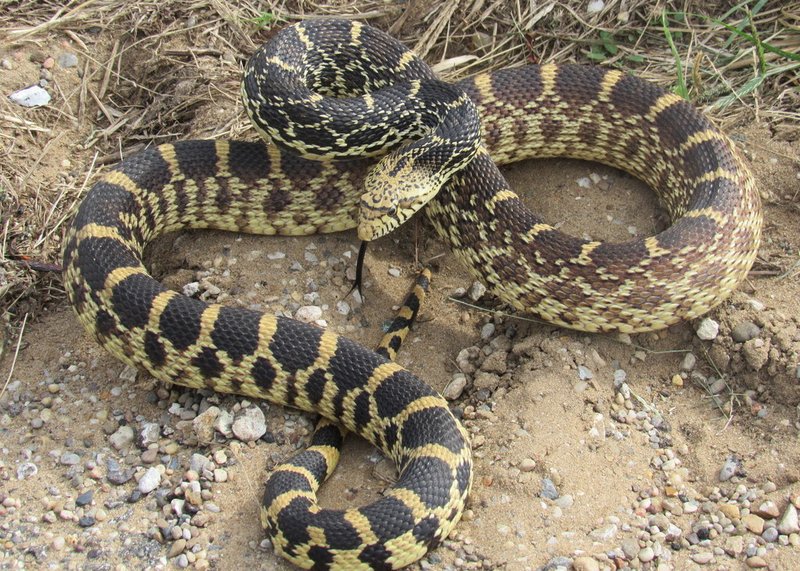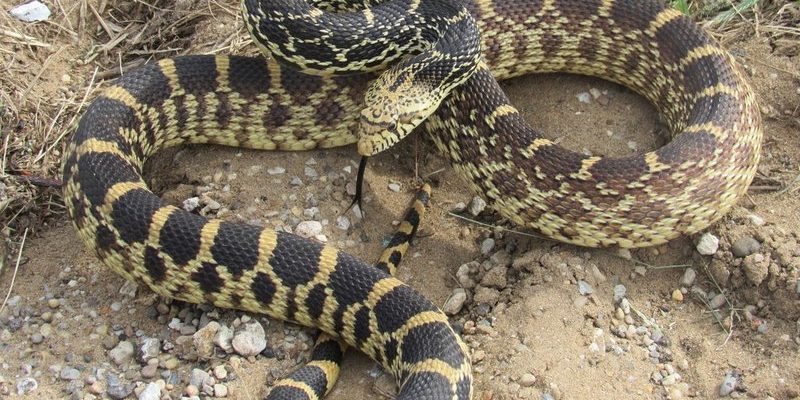
Picture this: you’re wandering through the sandy plains and rolling hills of North America, and suddenly, you catch a glimpse of a long, slender creature gliding effortlessly across the ground. This is no ordinary snake—it’s a bullsnake. Known for their impressive size and striking appearance, bullsnakes are often misunderstood yet captivating beings in the world of reptiles.
Bullsnakes are fascinating creatures for a variety of reasons, from their unique patterns to their behavior and habitat preferences. With the ability to mimic more dangerous snakes, they’ve earned both fear and a bit of admiration. If you’re curious to learn more about these remarkable animals, you’re in the right place. Let’s dive into the world of bullsnakes together, exploring their lives, habitats, and why they’re worth celebrating.
What is a Bullsnake?
A bullsnake, scientifically known as Pituophis catenifer sayi, is a subspecies of the gopher snake. They can stretch up to 8 feet in length, making them one of the largest non-venomous snakes in North America. Their bodies are typically adorned with beautiful yellow or cream backgrounds, decorated with dark, blotchy patterns that help them blend into their natural environment.
These snakes are native to the central and western parts of the United States, often found in grasslands, shrublands, and even rocky areas. Bullsnakes are known to be both calm and active, which makes them a fascinating subject for enthusiasts and researchers alike.
One of the fascinating characteristics of bullsnakes is their ability to mimic the behavior of rattlesnakes. When threatened, they may hiss loudly, flatten their bodies, and shake their tails, creating a sound that can resemble the rattle of a rattlesnake. This clever defense mechanism often deters potential predators, allowing them to escape without confrontation.
Physical Characteristics
Bullsnakes are impressive not only in their size but also in their striking physical features. As mentioned, they typically range from 6 to 8 feet long. Their robust build and the distinct patterning on their scales make them easy to identify. The ground color can vary from light yellow to cream, with darker brown or black markings that provide excellent camouflage in their natural habitat.
Their heads are slightly wider than their necks, which helps them consume larger prey. The shape of their head is another feature that can distinguish them from other snakes. When you catch a glimpse of a bullsnake, you’ll often notice their large, round eyes that have a keen ability to spot movement around them.
Not only that, but their scales are smooth to the touch and feature a characteristic sheen that glistens in the sunlight. This shimmer can make them even more eye-catching as they bask in the warmth and soak up the rays. All these traits contribute to their overall beauty and role in the ecosystem.
Habitat and Range
Bullsnakes thrive in a variety of habitats, showcasing their adaptability. They primarily inhabit open and semi-arid environments, including prairies, grasslands, and agricultural fields across the central and western United States. The range of a bullsnake can extend from southern Canada down through parts of Mexico, making them one of the more widespread snake species in North America.
They prefer areas with plenty of cover, like grasses and shrubs, which offer both shelter from the elements and hiding spots from predators. During warmer months, you can often find bullsnakes basking in the sun, soaking up warmth before heading off to search for prey.
A fascinating characteristic of bullsnakes is their burrowing behavior. They often seek out abandoned burrows of rodents or other small animals, which provide effective shelters from harsh weather conditions and predators. This burrowing also helps them hunt, as these locations can be teeming with various prey species.
Diet and Hunting Behavior
When it comes to food, bullsnakes have quite an appetite. Their diet consists primarily of small mammals, including mice, rats, and even ground squirrels. As skilled hunters, they rely on their excellent sense of smell and eyesight to locate prey. Once they identify a target, bullsnakes employ a hunting technique known as ambush hunting.
Using their keen camouflage, they lie in wait for unsuspecting victims to wander near. Once the time is right, they strike with lightning speed, using constriction to subdue their prey before swallowing it whole. It’s an effective method that highlights their role as predators in the ecosystem.
Interestingly, bullsnakes play a vital role in controlling rodent populations. By keeping these numbers in check, they help maintain a balanced ecosystem. So, while they might seem fearsome, they contribute positively to their environments and the health of other wildlife.
Reproduction and Lifespan
Bullsnakes are oviparous, meaning they lay eggs rather than giving birth to live young. Mating typically occurs in the spring, after the snakes emerge from hibernation. Female bullsnakes can lay between 6 to 24 eggs, depending on their size and health. These eggs are typically deposited in sandy, warm areas, often near the burrows of small mammals.
The eggs will incubate for about 60 to 90 days before hatching, with hatchlings being about 12 to 18 inches long. Young bullsnakes exhibit similar coloration and markings to adults, although they may be a bit more vibrant and striking.
In terms of lifespan, bullsnakes can live up to 20 years in captivity. In the wild, their life expectancy is often shorter due to predators, disease, and habitat loss. Being aware of these factors helps us understand the challenges they face and the importance of conservation efforts.
Behavior and Temperament
Bullsnakes are generally peaceful creatures, but they can show a range of personalities. During the day, you might see them basking in the sun or prowling for food. When they feel threatened, they can become defensive, hissing and puffing themselves up to appear larger. This behavior can be quite remarkable to observe but is often misunderstood as a sign of aggression.
Despite their sometimes intimidating display, many bullsnakes can be surprisingly docile, especially when handled gently. They often tolerate human interaction better than some other snake species. This adaptability in temperament makes them a popular choice as pets for snake enthusiasts.
Another notable behavior is their ability to roam large distances in search of food or mates. Bullsnakes have great endurance and can travel several miles within a day. This quality highlights their tenacity and adaptability in the ever-changing landscapes they inhabit.
Conservation Status
As of now, bullsnakes are not considered endangered; however, their populations can face threats from habitat destruction, agricultural practices, and persecution due to misconceptions about snakes. Many people fear snakes and may resort to killing them simply out of fear, which can contribute to declining numbers in certain areas.
Conservation efforts are essential to educate the public about the benefits of these incredible snakes. By understanding their ecological role and peaceful nature, we can work together to promote coexistence. Programs focused on habitat preservation, public awareness, and responsible land use can greatly aid in ensuring that bullsnakes continue to thrive in the wild.
As the stewards of our environment, it’s vital that we engage in practices that protect these beautiful reptiles and their habitats. Together, we can ensure that future generations have the chance to marvel at the beauty of bullsnakes in the wild.
Interesting Facts About Bullsnakes
| Scientific Name: | Pituophis catenifer sayi |
| Length: | 6 to 8 feet |
| Habitat: | Grasslands, shrublands, rocky areas |
| Diet: | Small mammals, birds, eggs |
| Lifespan: | Up to 20 years in captivity |
| Coloration: | Yellow or cream with dark blotches |
| Behavior: | Docile, defensive when threatened |
FAQ
Are bullsnakes venomous?
No, bullsnakes are non-venomous. They rely on their size and strength to subdue prey rather than venom. This makes them safe to handle, although it’s always best to exercise caution with any wild animal.
How do you tell the difference between a bullsnake and a rattlesnake?
While both snakes can be similar in size and coloration, rattlesnakes have a distinct rattle at the end of their tails, which bullsnakes lack. Additionally, rattlesnakes often have a triangular-shaped head, while bullsnakes have a more rounded head. When in doubt, it’s best to observe from a distance.
Can bullsnakes be kept as pets?
Yes, many people keep bullsnakes as pets due to their manageable size and generally docile demeanor. They require proper care, including an appropriately sized terrarium, heating, and a varied diet. Always ensure you’re obtaining a snake from a reputable source.
What do bullsnakes eat in the wild?
In the wild, bullsnakes primarily prey on small mammals like rodents, birds, and bird eggs. Their ability to hunt effectively helps control populations of these species, underscoring their important role in the ecosystem.
Do bullsnakes hibernate?
Yes, bullsnakes do hibernate. In colder regions, they will enter a state of brumation during the winter months. They seek shelter in burrows or other secure places to survive the cold until temperatures rise again in the spring.
Are bullsnakes aggressive?
Bullsnakes are generally not aggressive. While they may hiss and puff up when threatened, this is a defensive behavior. Many bullsnakes can be quite calm and tolerant when handled properly, making them suitable for those interested in observing them up close.
How can I help protect bullsnakes?
You can help protect bullsnakes by promoting awareness about their ecological importance, advocating for habitat preservation, and educating others about the benefits of living peacefully with wildlife. Engaging in conservation efforts can make a real difference.
What is the best way to observe bullsnakes in the wild?
The best way to observe bullsnakes in the wild is to visit their natural habitats during warm months when they are most active, especially in the early morning or late afternoon. Maintaining a respectful distance is crucial, as it allows you to enjoy watching them without causing stress.

